—story and photos by Kate Prengaman
—photos by TJ Mullinax
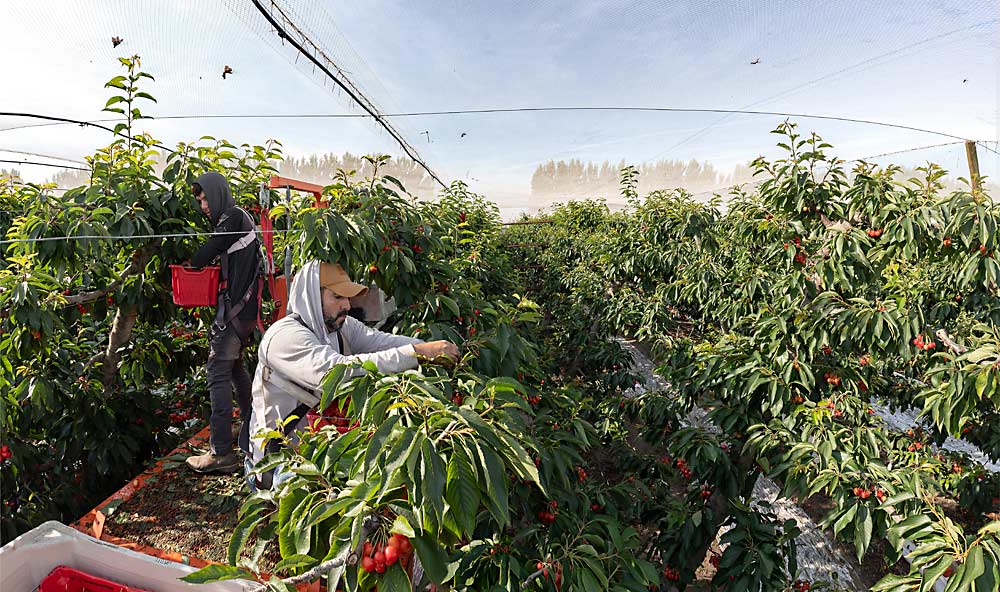
For some cherry growers, blush cherries were a buoy in the otherwise bleak 2023 market.
“That was the only cherry we made money on last year. That is what we are relying on every year,” said John Griggs Jr., who farms about 200 acres of cherries — half Rainiers — with his family in the Orondo, Washington, area.
While the price for dark sweets fell steadily as shippers tried to move the unprecedented daily volume, domestic pricing for Rainiers and other blush/yellow cherries held strong at over $5 per pound, according to the U.S. Department of Agriculture’s Agricultural Marketing Service — and they were even higher in the export market.
Hopefully those prices keep growers invested in growing the fragile, flavorful fruit, even as costs of production rise, said B.J. Thurlby, president of Northwest Cherry Growers.
“We don’t want to lose that shelf space (for yellow cherries). We battled for it for 30 years,” he said. “They definitely take extra work, but it comes through in the finished product. They are considered a true delicacy.”
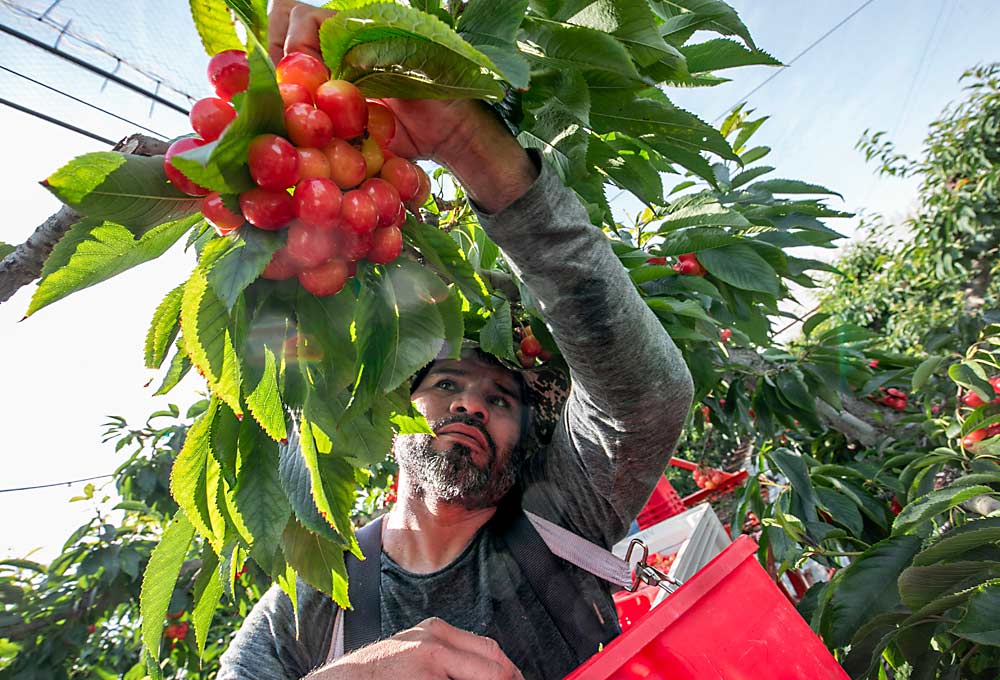
The shelf space has shrunk somewhat: In 2023, Northwest growers shipped 1.55 million boxes of blush cherries, shy of the previous five-year average of 1.9 million boxes. But Thurlby doesn’t see that as driven by the rising labor costs.
“For years, people were interspersing (Rainier) into Bings, and as those Bing orchards have aged out, so goes the Rainiers that were there for pollination purposes,” said Thurlby.
Some growers still grow them that way, but others have invested in higher-density, formally trained systems to grow the blush cherries with lower risk of bruising and better light penetration. Either way, blush cherry growers are looking to save harvest labor costs by reducing picking passes — through use of reflective mulch, summer pruning, plant growth regulators, and more — to keep production costs in check.
Prosser, Washington-area grower Gary Ormiston farms some of the oldest Rainier trees in the world. His father planted them in the early 1960s, when Washington State University released the variety as a pollinizer for Bing, and some growers saw potential as a cannery cherry.
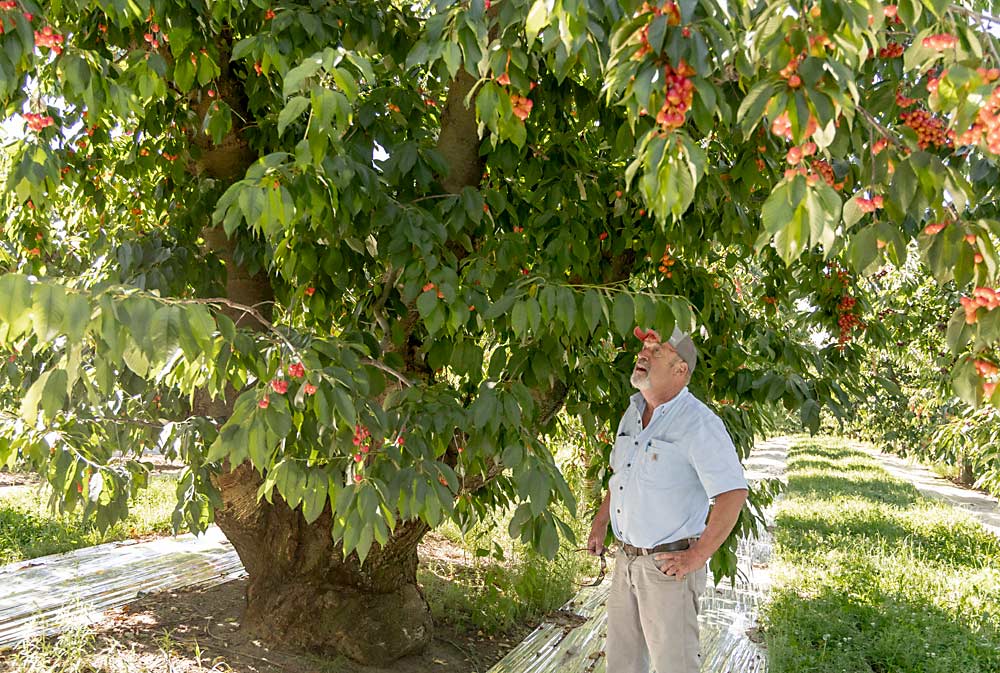
“If they weren’t Rainiers, these trees would have been gone a long time ago,” said Ormiston, who farms 150 acres of cherries, heavy on Rainiers. “I’m kind of old-school in my orchards, but the trees aren’t as big as they used to be — for labor reasons.”
With the premium prices the fruit brings, his dad’s trees still pay the bills, though it’s no longer his father’s horticulture. Ormiston has invested in reflective mulch to boost color and uses GA and the variation in elevation and slope to extend his Rainier season, along with some Early Robin plantings.
He’s also reduced his picking passes.
“In the past, I’d always try to target an early start and pick the tops for the early market money,” Ormiston said. He would follow that with two or three more passes, but recently he’s been testing out a one-pass approach. “Now, with heavier pruning to get the light in and the reflective mulch, I’m thinking this one-pick looks pretty good.”
It hurts to walk away from fruit on the trees, but the smaller passes just won’t pencil out, he said.
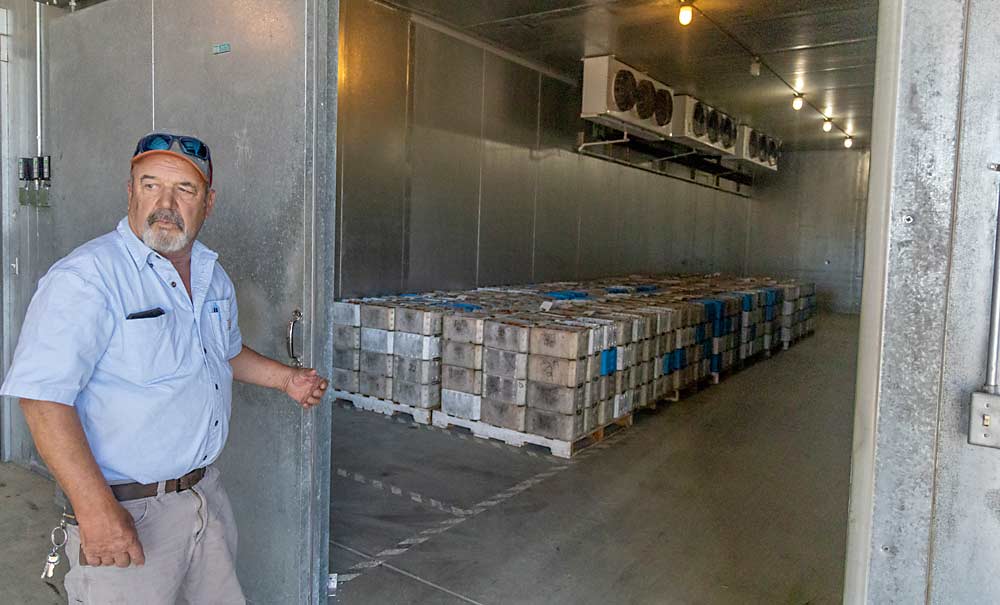
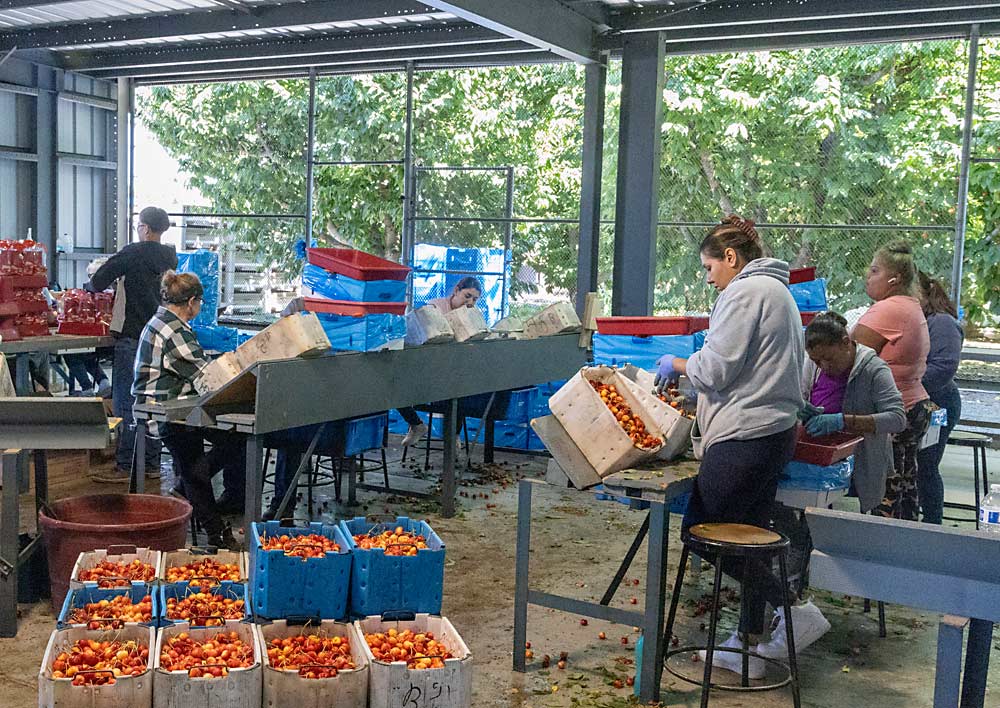
Ormiston also hand packs his Rainiers on the farm, hiring about 75 people for a short season, mostly employees of the local school district. It’s gentler on the easily bruised fruit and gives him more control of his costs, he said.
“That’s one thing I like about cherries in general is that I know what it’s costing me, and I know what the market is,” Ormiston said. “I know when to pull the plug,” And he did pull the plug on some Chelans last season.
Hans Groenke Jr., who farms in Mattawa, Washington, said he’s also aiming to get to a one-pick Rainier. That takes a lot of pruning in a 20-year-old orchard.
“We’re pruning for light penetration, pruning for renewal, pruning for efficiency. We get the foil put down and the plant growth regulators applied,” he said. “In my opinion, that’s all cheap insurance to keep a tree that’s easy to pick. If I can build those efficiencies into the system, we can get in and get out.”
Allan Bros. Inc. also invested in Rainier insurance, in the form of a fully netted orchard block in the Mesa, Washington, area. It primarily reduces wind damage, but it also reduces bird and sun damage.
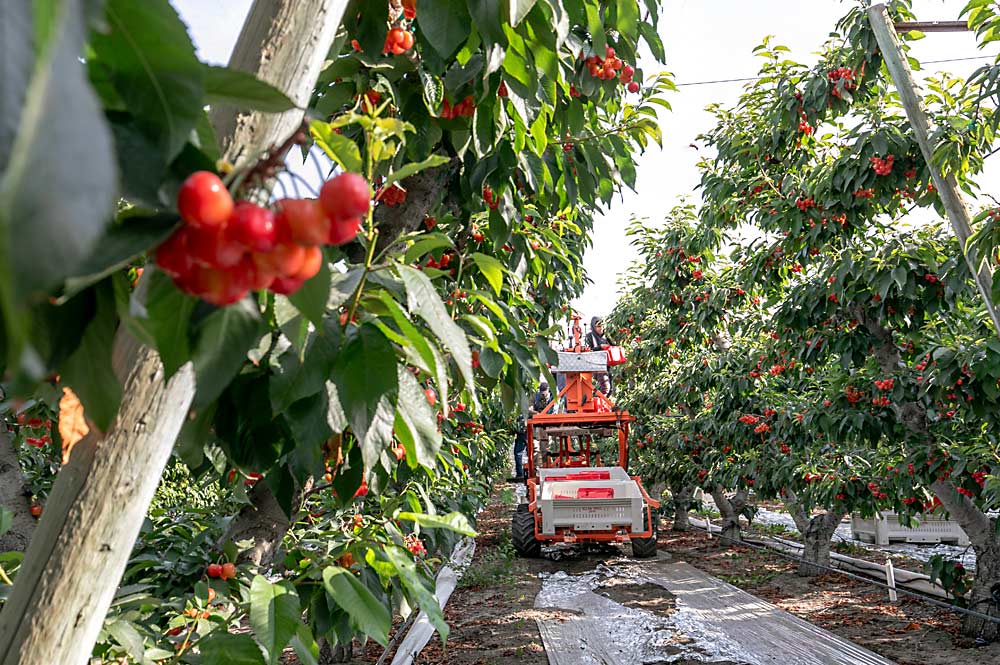
“It’s definitely helped the last few years,” said Greg Paganelli, Columbia Basin area manager for Allan Bros., referring to the nets that were retrofitted to the 2006 planting six years ago.
All of Allan Bros.’ blush cherries are formally trained, which boosts productivity and prevents the limbs from whipping around in the wind and bruising the fruit. The upfront investment in the system pays off with the ability to use platforms for pruning, thinning and picking, he said, though the blush cherries require more detailed pruning, as well as summer pruning.
“And then, we pay more cents per pound for pickers to pick slowly and carefully,” Paganelli said. “A perfect scenario would be two passes, but we often end up doing three.”
Last year, the block packed 8 tons an acre. That’s ideal from a quality standpoint, and if the crop load looks too high, based on counting buds per spur and the number of flowers per bud (which varies from season to season), they will bud thin, he said.
“We think bud thinning offers better results for fruit size” and quality than green fruit thinning, he said.
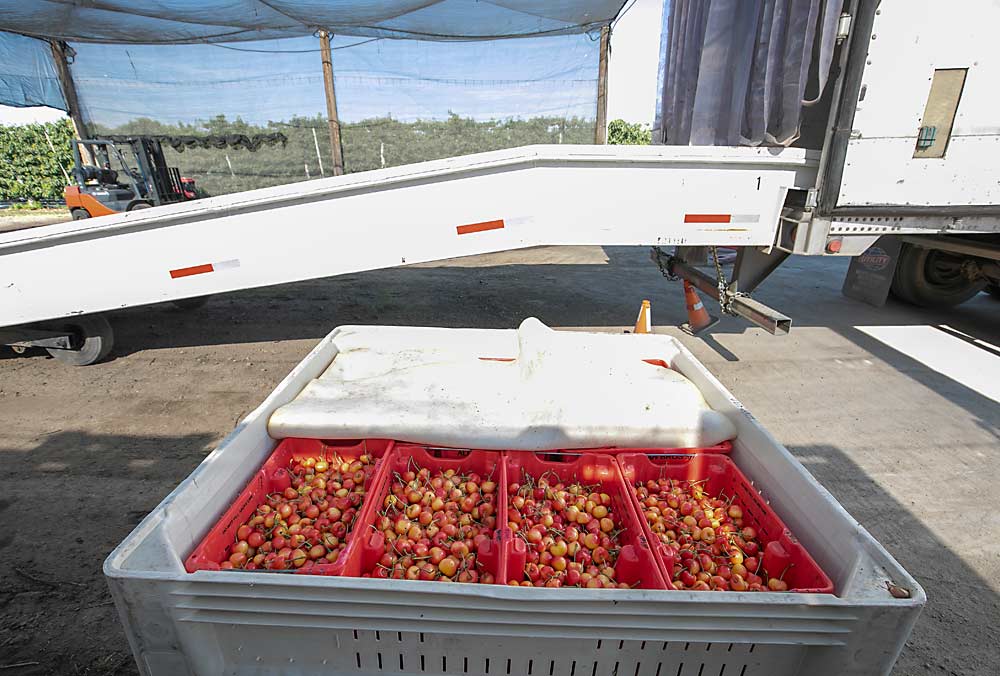
The Griggs family, on the other hand, isn’t looking to reduce passes. It takes three to four picks to get the quality the export market requires on Rainiers and their proprietary blush variety, the Orondo Ruby, despite the cost, Griggs said.
“We do whatever it takes to grow quality fruit,” he said. “I’m not sure that’s a good way to look at it anymore,” he added, considering rising labor costs.
His family, one of the first to start growing Rainiers on V-trellis in the 1990s, has invested in platforms to save labor costs and electrostatic sprayers to reduce chemical bills, but there is little room to cut other costs or increase productivity without sacrificing quality, he said.
Quality is key for Rainier and the other specialty cherries, such as the proprietary blush Skylar Rae and Strawberry Cherry, said Rochelle Bohm, vice president of marketing for CMI Orchards. She considers them an ultrapremium product that drives consumer and retail engagement.
“Having multiple varieties helps cherries be top-of-mind for consumers,” she said, and the specialty varieties help CMI develop programs with retailers who want to offer those options. “We can’t keep the shelves stocked with enough of these specialty cherries, and it opens the door to filling the truck with the reds we need to move.”
Prices should continue to reflect that.
“Yes it’s high risk, but if you do it right, there’s opportunity for good rewards,” she said. •






Leave A Comment